The flamingo flower comes in many variations. You can find out here how the posture works and how to avoid common care mistakes.

Flamingo flowers immediately catch the eye with their colorful or strikingly patterned leaves and are therefore very popular. Because of their brightly colored bracts, the small flamingo flower (Anthurium scherzerianum) and the great flamingo flower (Anthurium andreanum), as well as their hybrids. Not only can they be planted in soil, but they can even thrive in water. How it works? These and other questions about the care, location and reproduction of the two types of flamingo flowers are answered in this article.
"Contents"
- Flamingo flower: origin and characteristics
-
Plant anthurium
- The right location for the anthurium
- The right soil for the anthurium
- Plant the flamingo flower in a pot
- Keep anthurium in the water
-
Care of the anthurium
- Water the anthurium properly
- Fertilize anthurium: timing and choice of fertilizer
- Cut back the anthurium
- Repot the anthurium
- Brown leaves on the flamingo flower: what to do?
- Flamingo flower does not bloom: causes and measures
- Propagating anthurium: offshoots, seeds and Co.
- Proper wintering
- Common diseases and pests
- Is the flamingo flower poisonous?
Flamingo flower: origin and characteristics
The flamingo flowers belong to the Araceae family and originally come from the tropics of Central and South America. As far as we know today, the genus includes around 1000 different species. Often found in our living spaces Anthurium species are the little flamingo flower (Anthurium scherzerianum) and the great flamingo flower (Anthurium andreanum) or crosses of both species.
Anthuriums are evergreen and often have strikingly colored, sheath-shaped bracts in white, pink or red, which are also called spathe. The actual flower, however, is typical of the arum family, piston-shaped and rather inconspicuous and is surrounded by the bract. The decorative leaves of the large flamingo flower are heart-shaped and glossy and can be up to 40 cm long. The small flamingo flower has elongated, rather dull leaves that can reach a length of 30 cm. It is often richer in flowers than the great flamingo flower.
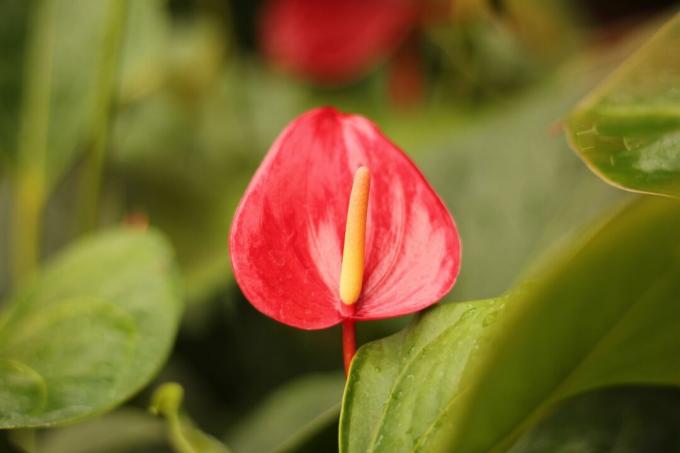
Plant anthurium
Anthuriums can be traditionally planted in soil, but they can also be kept in hydroponics. They require a little maintenance, but this can be rewarded with year-round and abundant flowering.
The right location for the anthurium
Flamingo flowers like it, according to their tropical origin, warm and humid. The anthurium feels most comfortable in a sunny or partially shaded place without direct sunlight. Drafts should be avoided. The temperature is best in summer 20 to 25 ° C, in winter 16 to 18 ° C is enough. Especially in the case of the small flamingo flower, these low temperatures encourage blooming in the next spring, which is also known as the cold stimulus.
The right soil for the anthurium
The substrate for the anthurium should above all be loose and permeable and have a high humus content. The flamingo flower does not tolerate lime and prefers an acidic to moderately acidic pH value between 4.5 and 5.5. For example, a green or houseplant soil is well suited. The anthurium also thrives well in a mixture of one third each of sand, leaf compost and peat, although the use of peat is not recommended for environmental reasons. A sustainable alternative would be our peat-free one, for example Plantura organic universal soil mixed with sour grape marc.

Plant the flamingo flower in a pot
If the flamingo flower is to be cultivated in a pot, it is important that it has a drainage hole in the bottom. Now a drainage layer, for example made of pottery shards, can be filled in. This ensures that the water can always drain off well and that no water build-up occurs. The anthurium is then planted in a suitable substrate. To be on the safe side, gloves should be worn, as contact with the plant can cause skin irritation. In addition, the soil can be covered with moss to protect the soil and the roots from drying out.
Keep anthurium in the water
It is also possible to keep the anthurium in water. Most flamingo flowers can easily adapt to this type of keeping, but then grow a little slower than in the ground. However, if the leaves turn yellow, it is better to put the plant back into a suitable substrate.
To keep the anthurium hydroponic, you first rinse the roots of the plant with lukewarm water, which removes any remnants of the earth. Now the flamingo flower simply has to be placed in a container with water so that the roots are just covered. If you hold the anthurium in the glass, you can even watch the roots grow. It is important to use water with little lime, such as rainwater. The water should be changed and the container cleaned every three weeks. In order to provide the flamingo flower with the necessary nutrients, a little plant food or a drop of fertilizer is added every now and then.
In the long run, however, keeping the plant in real hydroponics or soil is better than keeping it in a glass. For hydroponics you need a watertight planter in which the water and a special nutrient solution are filled and a water level indicator is attached. In the inner pot is the plant, which is held with the help of granules, for example expanded clay. This allows enough oxygen to reach the roots. If the water level sinks below the minimum line, it has to be poured again. When keeping it in the water, it is particularly practical that the humidity is automatically increased and you have to water less often.
Hydroponics and hydroponics in comparison:
Hydroponics:
- Hydroponics in the glass look very decorative.
- Roots are completely covered with nutrient solution (can lead to oxygen starvation and overfertilization in the long run).
- Water needs to be changed regularly.
Hydroponics:
- Use of substrate (e.g. B. Expanded clay) to give the plant support and to supply it with oxygen.
- Less watering thanks to the water level indicator (also allows watering in advance).
- The plant uses the roots to get everything it needs from the nutrient solution in the planter (less risk of over-fertilization).
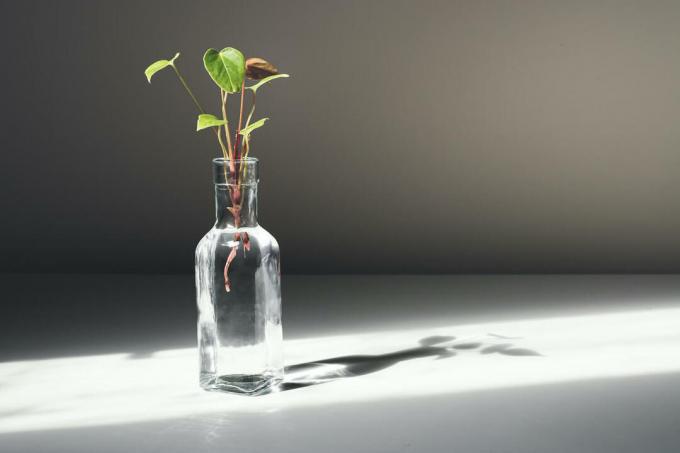
Care of the anthurium
In order to give the flamingo flower the care it needs, only a few things need to be considered. With a little practice, the posture succeeds without any problems.
Water the anthurium properly
When watering, it is especially important that the substrate never dries out, but that the plants do not stand in the water either. You should therefore water regularly, but not too much, and remove excess water from the planter or saucer. In addition, flamingo flowers do not tolerate lime, which is why decalcified water or rainwater should be used. It is best to pour water at room temperature.

Fertilize anthurium: timing and choice of fertilizer
From time to time the flamingo flower needs new nutrients through fertilization. It should be fertilized regularly but little. This means that in summer fertilization takes place every two weeks, in winter approximately every two months and only in half the concentration. Since the anthurium is sensitive to too much salt, a primarily organic fertilizer should also be used. For example, ours is suitable for this Plantura organic indoor & green plant fertilizer, which provides the flamingo flower with all the nutrients it needs. Beneficial microorganisms in the organic fertilizer also stimulate root growth and improve the availability of nutrients.
tip: If the anthurium is kept in water, a special hydroponic fertilizer is absolutely necessary, which provides all the essential nutrients.
Cut back the anthurium
The flamingo flower does not have to be cut back. Only brown and dry leaves should be cut off at the base with a sharp knife. If you want to cut back the anthurium, you can do that without any problems. The severed stems are then kept in a vase for some time.
Repot the anthurium
Young anthuriums should be repotted every spring when the growth phase begins. With older plants, it is sufficient to replace the upper substrate layer or to repot them every three to four years. Since the skin can be sensitive to contact with the anthurium, it is advisable to use gloves when repotting. The flamingo flower is then placed in a larger pot that corresponds to its root mass. Rotten roots should be removed before planting.
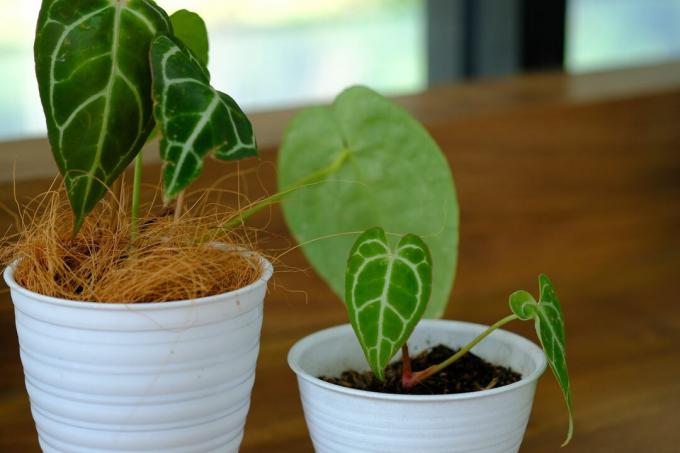
Brown leaves on the flamingo flower: what to do?
If the flamingo flower gets brown leaves, this can have various causes. In any case, brown and dried up leaves should be removed so that the plant does not invest further energy in them. Possible causes of leaf discoloration are:
- Too much direct sun: The anthurium should be placed in a place without direct sun.
- Too much or too little water: It can help to change the water supply over a period of time and observe how the plant is developing.
- Too little humidity: This is also expressed in curling leaves. The plant should then be sprayed with low-lime water from time to time.
Tip: The most common mistakes when caring for the flamingo flower are too hard water, too low temperatures or too little humidity.
Flamingo flower does not bloom: causes and measures
There can also be different reasons for missing flowers. The following causes often lead to reduced flower formation:
- Too little light: The flamingo flower does not tolerate direct sunlight, but the location should be bright enough.
- Too little fertilizer: Without sufficient nutrients, the anthurium cannot produce flowers.
- Wrong nutrient ratio: For flower formation, the plant primarily needs potassium and a little less nitrogen, as the latter promotes the growth of green parts of the plant.
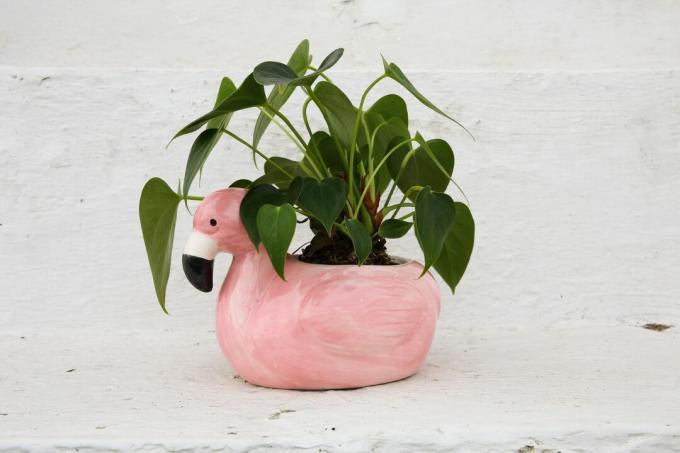
tip: Especially with the small flamingo flower, a cold stimulus helps to stimulate flower formation. For this purpose, the plant should be kept at 16 to 18 ° C for about six weeks in winter. During this time it also needs a little less water and no fertilizer. As soon as it comes back into the warmth and is regularly cared for, flowers should begin to develop.
Propagating anthurium: offshoots, seeds and Co.
The easiest way to propagate the anthurium is that Division of old mother plantswhich often even form rooted side shoots. You can use repotting in spring for this purpose. The flamingo flower can then be divided at the root ball. It is important that all parts have sufficient roots and at least one leaf. The daughter plants are then planted in their own pots and placed in a bright and warm place. If the anthuriums are still small, increasing the humidity can help. For this you can put a plastic bag over the plant and pot, for example. This must be removed regularly to prevent mold from forming. Gloves should also be worn when propagating the flamingo flower for safety.
Another method is that Propagation by cuttings. For this, some stems are cut off at the base with a sharp knife and all leaves are removed except for the upper ones. The cutting can later form roots in these places. It is now placed in a glass of water in a bright, warm place. The water should be changed regularly. It can take a few weeks for the anthurium to form sufficient roots and be ready for planting.
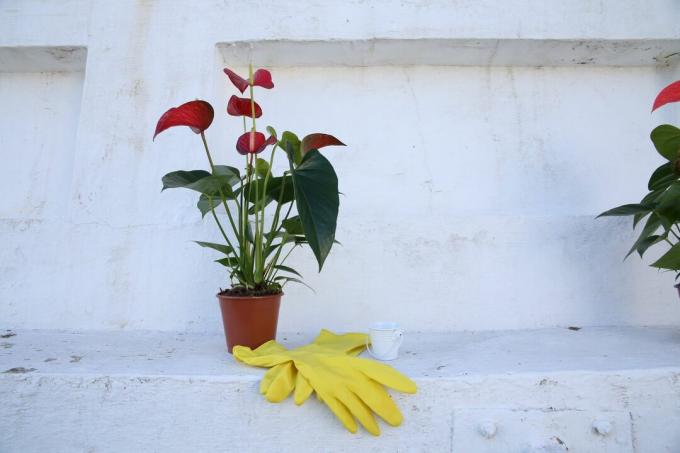
One Propagation of the flamingo flower by seeds is only possible if the plant has been fertilized. Because flamingo flowers clearly prefer cross-pollination, several plants of the same species are needed to harvest seeds. With successful fertilization, the often colorful fruits tend to form slowly within a year. Therefore the withered flower stalks must not be removed. When the berries are ripe, they have to be harvested and the seeds removed from the fruit. The seeds should then be washed off and used quickly, as the germination capacity is already greatly reduced after 24 hours. Then it can be sown on an acidic, nutrient-poor potting soil and lightly pressed, but not covered with soil. The whole thing should be kept well moist. It is best to stretch cling film over the sowing vessel and provide it with a few air holes, this increases the humidity. Germination should begin after about two weeks.
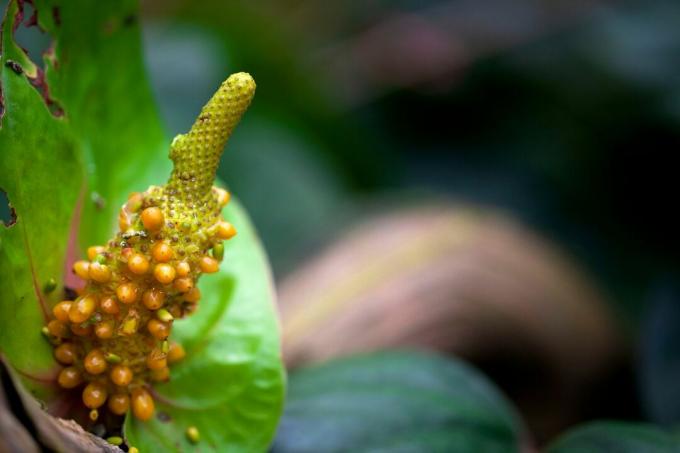
Proper wintering
Hibernating the flamingo flower is not difficult and can even contribute to increased flower formation. In winter, the anthurium mainly needs:
- A lower temperature than in summer, preferably between 16 and 18 ° C, but not colder.
- Less water, but the root ball should never dry out completely.
- Fertilization only every six to eight weeks, as the growth phase does not begin again until spring.
Common diseases and pests
Sometimes the flamingo flower can be attacked by pests. The most common pests are:
- Spider mites: Recognizable by a fine web and brown discolored leaves.
- Mealybug: Sluggish lice that leave bright spots on the leaves.
- Leaf spot disease: In rare cases, leaf blotch disease can also be the cause of blotchy discoloration and withered leaves.
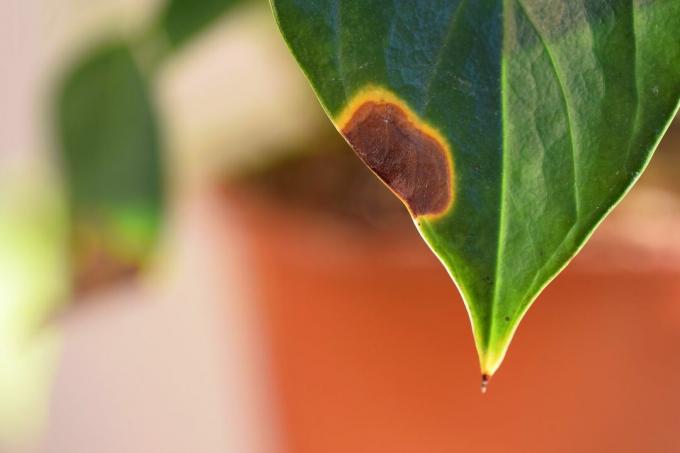
Is the flamingo flower poisonous?
Like most arum plants, the flamingo flower is also slightly toxic to humans and animals. Contact can cause skin irritation, in particular contact with mucous membranes and eyes should be avoided. Consumption can lead to gastrointestinal complaints. However, the leathery leaves tend to keep animals from eating the plant. When repotting or propagating, gloves should be worn for safety.
A colorful flamingo flower is not enough for you? Further flowering houseplants for your home we present to you in our special article.
